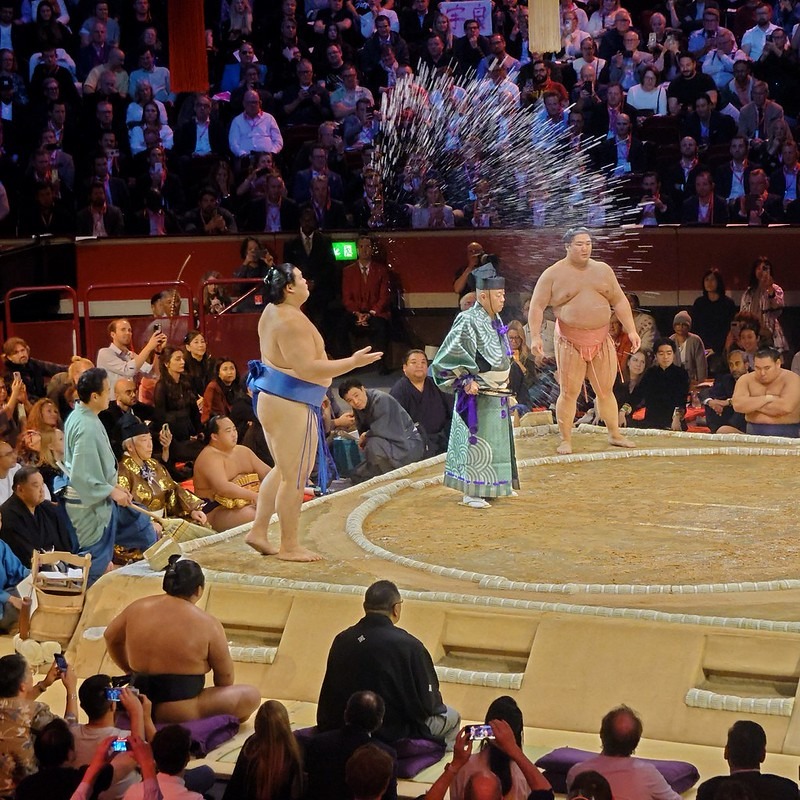What made London’s Grand Sumo Tournament so spectacular?
Steeped in tradition and discipline, Sumo wrestling has for over a millennia formed an integral pillar of Japanese culture.
With a history dating back in legend to 23BCE, the captivating sport’s Grand Tournament has been held outside its native country just twice in over 1,500 years – the second time being last week, in London’s Royal Albert Hall.
Instantly recognisable through the intricate rituals, salt-throwing spectacles, and Shinto traditions performed by stocky fighters (rikishi) and immaculately attired referees (gyōji), Sumo itself consists of intense, fast-pace bouts showcasing elite strength and power.
The winning condition for each match is to either make the opponent touch the ground with any part of the body aside from the soles of their feet, or push them out of the arena (dohyo) altogether.
The highest ranking rikishi, who earn their stripes across six yearly tournaments each lasting fifteen days, are those who have mastered all 82 of the permitted techniques (kimarite) to secure victory.
With no weight or height classes in Sumo, matches between rikishi can often resemble a bout between David and Goliath
The resources and specifications required to construct a dohyo and accommodate its athletes may owe some explanation as to why the professional art of Sumo has remained largely confined to Japan for so long.
Best known for hosting orchestral concerts, the Royal Albert Hall underwent a monumental transformation to become suitable for a five day tournament featuring forty of the world’s best rikishi.
Reinforced seats capable of supporting 200kg were purchased, rice wholesalers went out of stock, and a six-tonne Japanese temple roof was raised above the small circle of clay and earth which marks the dohyo. The result was a world-class arena, perfectly equipped for the suspense and dramatic atmosphere of Sumo.
Audiences lucky enough to purchase tickets for the event were treated to an enthralling mix of rich culture and ready athleticism. With no weight or height classes in Sumo, matches between rikishi can often resemble a bout between David and Goliath, as giant frames come up against shorter statures.
One star of the show falling into the latter category was Tobizaru Masaya, who is best described by his nickname, ‘The Flying Monkey.’
Competing with other high-ranking rikishi often twice his size, Tobizaru wowed audiences with his unexpected strength and agility, finishing the tournament with a record of 4 wins and 1 loss.
Only two current rikishi hold the highest possible rank of Yokozuna, and it was one of these fighters, Hoshoryu Tomokatsu, who was crowned winner of the tournament.
Hailing from Mongolia, Hoshoryu continues a decades-long dominance of the sport by rikishi of his nationality. His opponent in the final bout, Yokozuna Onosato Daiki, is the first Japanese grand champion of the sport in six years.
As a blend of tradition and modernity, the sport has not gone without scandal and controversy in recent years
The success of the tournament rides upon a wave of international recognition for Sumo, largely through a growing internet fanbase.
The sport surged in popularity during Covid, where many bored Brits stumbled across videos of tournaments on social media and were instantly hooked.
The cultural exchange in London went both ways, with many of the participating rikishi making a splash around the capital. Pictured doing anything from riding bikes to eating hot dogs, a brand new British audience has been won over by the ‘charm’ of Sumo and its disciplined yet friendly rikishi.
As a blend of tradition and modernity, the sport has not gone without scandal and controversy in recent years.
The continued ban on women wrestling professionally, as well as questions over athlete care and treatment in training stables, show Sumo to lag behind other martial arts in accessibility for its participants.
Nevertheless, the five enthralling days of Sumo at the Royal Albert Hall seem to have successfully converted thousands more fans to the sport. The European tour will continue in 2026, with another major tournament scheduled to take place in Paris.

Comments